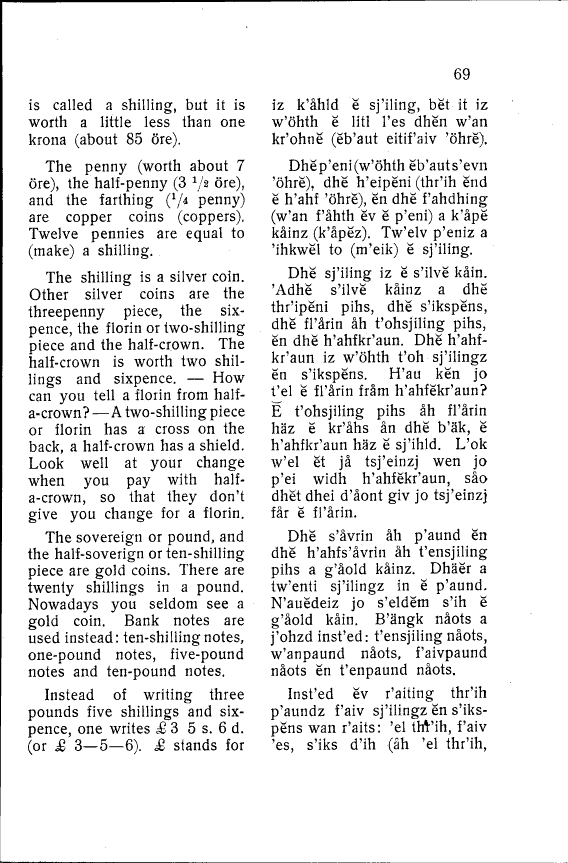
Full resolution (TIFF) - On this page / på denna sida - Läsestycken - 34. Coins and Measures

<< prev. page << föreg. sida << >> nästa sida >> next page >>
Below is the raw OCR text
from the above scanned image.
Do you see an error? Proofread the page now!
Här nedan syns maskintolkade texten från faksimilbilden ovan.
Ser du något fel? Korrekturläs sidan nu!
This page has never been proofread. / Denna sida har aldrig korrekturlästs.
is called a shilling, but it is
worth a little less than one
krona (about 85 ore).
The penny (worth about 7
ore), the half-penny (3 l/2 ore),
and the farthing (*/4 penny)
are copper coins (coppers).
Twelve pennies are equal to
(make) a shilling.
The shilling is a silver coin.
Other silver coins are the
threepenny piece, the
sixpence, the florin or two-shilling
piece and the half-crown. The
half-crown is worth two
shillings and sixpence. — How
can you tell a florin from
half-a-crown? —A two-shilling piece
or florin has a cross on the
back, a half-crown has a shield.
Look well at your change
when you pay with
half-a-crown, so that they don’t
give you change for a florin.
The sovereign or pound, and
the half-soverign or ten-shilling
piece are gold coins. There are
twenty shillings in a pound.
Nowadays you seldom see a
gold coin. Bank notes are
used instead: ten-shilling notes,
one-pound notes, five-pound
notes and ten-pound notes.
Instead of writing three
pounds five shillings and
sixpence, one writes £ 3 5 s. 6 d.
(or £ 3—5—6). £ stands for
69
iz k’åhld ĕ sj’iling, bet it iz
w’öhth ĕ litl 1’es dhĕn w’an
kr’ohnĕ (ĕb’aut eitif’aiv ’öhre).
Dhĕp’eni(w’öhth ĕb’auts’evn
’öhre). dhĕ h’eipĕni (thr’ih ĕnd
ĕ h’ahf ’öhre), ĕn dhĕ f’ahdhing
(w’an f’åhth ĕv ĕ p’eni) a k’åpĕ
kåinz (k’åpĕz). Tw’elv p’eniz a
’ihkwĕl to (m’eik) ĕ sj’iling.
Dhĕ sj’iling iz ĕ s’ilvĕ kåin.
’Adhĕ s’ilvĕ kåinz a dhĕ
thr’ipĕni pihs, dhĕ s’ikspĕns,
dhĕ fl’årin åh t’ohsjiling pihs,
ĕn dhĕ h’ahfkr’aun. Dhĕ
h’ahfkr’aun iz w’öhth t’oh sj’ilingz
ĕn s’ikspĕns. H’au ken jo
t’el ĕ fl’årin fråm h’ahfĕkr’aun?
E t’ohsjiling pihs åh fl’årin
häz ĕ kr’åhs ån dhĕ b’äk, ĕ
h’ahfkr’aun häz ĕ sj’ihld. L’ok
w’el ĕt jå tsj’einzj wen jo
p’ei widh h’ahfĕkr’aun, såo
dhĕt dhei d’åont giv jo tsj’einzj
får ĕ fl’årin.
Dhĕ s’åvrin åh p’aund ĕn
dhĕ h’ahfs’åvrin åh t’ensjiling
pihs a g’åold kåinz. Dhäĕr a
tw’enti sj’ilingz in ĕ p’aund.
N’auĕdeiz jo s’eldĕm s’ih ĕ
g’åold kåin. B’ängk nåots a
j’ohzd inst’ed: t’ensjiling nåots,
w’anpaund nåots, f’aivpaund
nåots ĕn t’enpaund nåots.
Inst’ed ĕv r’aiting thr’ih
p’aundz f’aiv sj’ilingz ĕn
s’ikspĕns wän r’aits: ’el thVih, f’aiv
’es, s’iks d’ih (åh ’el thr’ih,
<< prev. page << föreg. sida << >> nästa sida >> next page >>